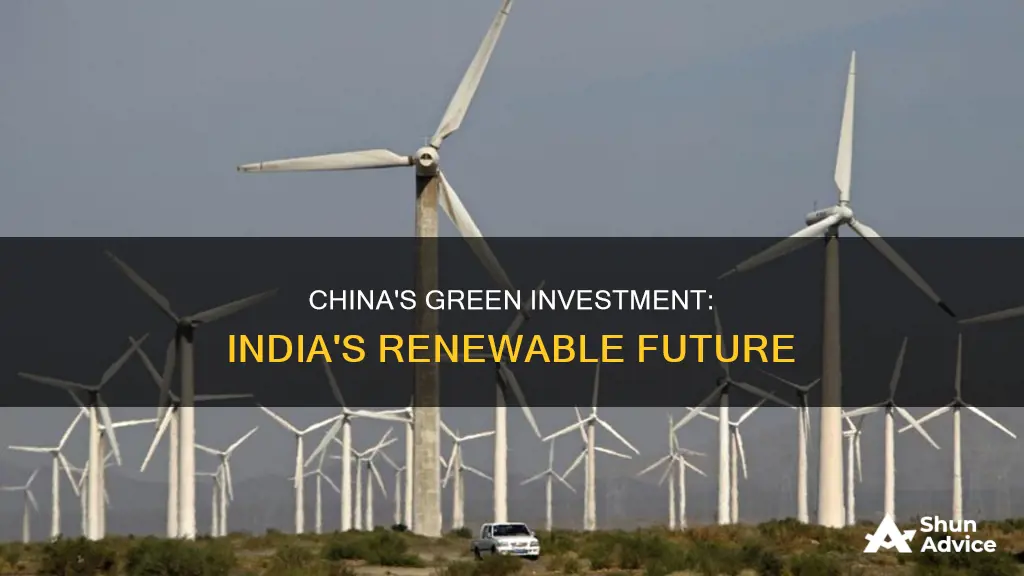
China is the world's largest investor in renewable energy, and its companies accounted for four of the top five biggest renewable energy deals made in 2016. In 2017, China's investments in renewable energy totalled US$126.6 billion, or 45% of global investments. As of 2024, China is the world's largest producer of photovoltaic power and solar panels.
India is the third-largest energy-consuming country in the world and has the fourth-largest renewable energy installed capacity. India's energy transformation could offer compelling investment opportunities in power generation, transmission and distribution, renewables, and other green technologies. India has already quadrupled its renewable energy capacity in the last eight years, and it is committed to commissioning 500 GW of renewable energy capacity by 2030.
Given China's position as a global leader in renewable energy and India's rapidly growing renewable energy sector, there are strong arguments for why China should invest in renewable energies in India.
What You'll Learn

India's renewable energy capacity
India is the world's third-largest consumer of electricity and the third-largest renewable energy producer. In 2022, 40% of its energy capacity came from renewable sources, and it has committed to a goal of 500 GW of renewable energy capacity by 2030.
India's installed renewable energy capacity is expected to increase to about 170 GW by March 2025, up from 135 GW in December 2023. This includes solar, wind, biomass, small hydropower, waste-to-energy, and large hydropower. As of July 2024, renewable energy sources had a combined installed capacity of 150.27 GW.
The Indian government has set a target of 50% of its total electricity from non-fossil fuel sources by 2030, with an intermediate target of 175 GW by 2022. This includes 100 GW of solar power, 60 GW of wind energy, and 15 GW from other technologies like biomass and small hydropower.
India's solar energy capacity has seen a 26-fold increase in the last 9 years, standing at 73.32 GW as of December 2023. The country has 3 of the world's top 5 largest solar parks, including the world's largest 2255 MW Bhadla Solar Park in Rajasthan. India also has the world's first and only 100% solar-powered airport in Cochin, Kerala.
Wind power in India has a strong manufacturing base, with 20 manufacturers of 53 different wind turbine models of international quality. India is ranked fourth in wind power capacity and solar power capacity, and fourth in renewable energy installed capacity.
In addition to solar and wind, India is also focusing on green hydrogen, with a target of producing 5 million tonnes by 2030, supported by 125 GW of renewable energy capacity.
The Indian government's initiatives, such as the PM-KUSUM scheme, and its commitment to reaching net-zero emissions by 2070, have spurred unprecedented growth in the renewable energy sector. India's renewable energy goals are transforming its power sector, and it is expected to become a hub for renewable energy investments.
Savings Transform to Investment: When and How?
You may want to see also

China's renewable energy sector growth
China's renewable energy sector is growing faster than its fossil fuels and nuclear power capacity, and is expected to contribute 43% of global renewable capacity growth. China's total renewable energy capacity exceeded 1,000 GW in 2021, accounting for 43.5% of the country's total power generation capacity. The country aims to have 80% of its total energy mix come from non-fossil fuel sources by 2060 and achieve a combined 1,200 GW of solar and wind capacity by 2030. China is on track to reach this target six years ahead of schedule.
China is the world's largest investor in renewable energy, accounting for 45% of global investments in 2017. It is also a major leader in clean energy technology, with Chinese renewable manufacturing driving down the costs of renewable energy technologies. China has become a world leader in the manufacture of solar photovoltaic technology, producing 63% of the world's solar photovoltaics (PV). It is the world's largest producer of electric vehicles and buses.
China's renewable energy sector benefits from the country's ability to manufacture at scale and quality, and deploy funds competitively. This is supported by consistent state support, highly integrated supply chains, cut-throat competition, indigenous innovation, entrepreneurship, and economies of scale. China's renewable energy sector growth is driven by policies that promote the use of clean energy and domestically manufactured technology. The Renewable Energy Law, passed in 2005, established a framework for regulating renewable energy and created mechanisms to promote its development.
China's renewable energy sources include hydroelectric, solar, and wind power. Hydroelectric power is the largest component of renewable electricity production, followed by wind and solar power. China has the largest wind resources in the world, with three-quarters located at sea. The country has identified wind power as a key growth component of its economy and encourages foreign investment in this area. China's solar exports grew by 64% in 2022, with Europe being the primary destination.
China's renewable energy sector faces some challenges, such as grid connection issues and voltage limits, which can hinder the absorption of electricity into the grid. However, the country is working to address these issues through infrastructure initiatives and technological solutions.
Lucrative Investment Zones Across India
You may want to see also

India's economic growth
India's renewable energy sector is rapidly expanding, with a 396% increase in installed non-fossil fuel capacity in the last 8.5 years. As of September 2024, India's renewable energy capacity, including large hydropower, stood at over 200 GW. The country has also achieved its target of 40% installed electric capacity from non-fossil fuels in November 2021, ahead of schedule.
India's solar energy capacity has seen remarkable growth, increasing by 30 times in the last 9 years to reach 90.76 GW as of September 2024. Wind energy capacity has also increased significantly, growing from 21 GW in 2014 to 47.36 GW. Additionally, India has approved 50 solar parks with an aggregate capacity of 37.49 GW.
The Indian government has implemented various initiatives to promote renewable energy, such as the Production Linked Incentive (PLI) Scheme and the National Green Hydrogen Mission. The government has also committed to reducing India's total projected carbon emissions by 1 billion tonnes by 2030 and enhancing energy efficiency.
The transition to clean energy in India offers significant economic opportunities. The development of renewable energy sources, such as solar and wind power, is expected to attract investments of over $250 billion. India is well-positioned to become a global leader in renewable batteries and green hydrogen, with these low-carbon technologies potentially creating a market worth up to $80 billion by 2030.
To achieve its net-zero emissions target, India requires significant investments in its energy sector. According to the IEA, an average of $160 billion per year is needed across India's energy economy between 2024 and 2030. Access to low-cost, long-term capital is crucial to achieving net-zero emissions.
Diversifying Your Investment Portfolio: Strategies for Spreading Risk
You may want to see also

China's energy security
China has become a world leader in renewable energy, with its companies accounting for four of the top five biggest renewable energy deals made in 2016. China's renewable energy sector is growing faster than its fossil fuels and nuclear power capacity, and is expected to contribute 43% of global renewable capacity growth.
China's renewable energy capacity exceeded 1,000 GW in 2021, accounting for 43.5% of the country's total power generation capacity. China aims to have 80% of its total energy mix come from non-fossil fuel sources by 2060 and achieve a combined 1,200 GW of solar and wind capacity by 2030.
China's renewable energy sector provides energy security and reduces carbon emissions. Unlike oil, coal and gas, renewable energy systems can be built and used wherever there is sufficient water, wind, and sun. China's Action Plan for the Prevention and Control of Air Pollution illustrates the government's desire to increase the share of renewables in China's energy mix.
China's renewable energy sector has also driven down prices worldwide, reducing the cost barrier for poorer countries to adopt renewable energy systems.
China's renewable energy capacity is expected to continue increasing, with the IEA projecting that China would contribute nearly 60% of global renewable energy capacity by 2030, with solar power driving 80% of the growth.
However, there are challenges to China's renewable energy sector, including grid connections and voltage limits, which have resulted in curtailment issues. China is working to address these challenges through the development of more long-distance, high-voltage transmission lines.
In summary, China's renewable energy sector provides energy security, reduces carbon emissions, and drives down prices worldwide. China is expected to continue its rapid growth in renewable energy capacity, but it must address challenges related to grid connections and voltage limits.
Tiger Global Management: How to Invest Like a Pro
You may want to see also

India's energy consumption
India is the world's third-largest energy consumer, with a total energy consumption of 1.14 Gtoe in 2023. This figure has been increasing significantly, with a growth rate of 6.5% per year since 2020 (5% in 2023).
Coal is India's primary energy source, with a share of 49% in 2023, followed by oil (22%) and biomass (20%). Natural gas covers 5% of the country's energy needs, while primary electricity (hydro, nuclear, solar, and wind) accounts for 4%.
Electricity consumption in India reached 1407 TWh in 2023, with a per capita consumption of 985 kWh. The country aims to achieve 50% of its cumulative electric power installed from renewables by 2030.
India's installed non-fossil fuel capacity has seen impressive growth, increasing by 396% in the last 8.5 years to stand at more than 209.63 GW as of September 2024. This includes sources such as large hydro and nuclear, wind, solar, biomass, small hydro, waste-to-energy, and large hydro.
Solar energy has witnessed remarkable progress, with a 30-fold increase in installed capacity over the last nine years, reaching 90.76 GW as of September 2024. India also ranks highly in wind power capacity, standing at 47.36 GW, and has set ambitious targets for further expansion in renewable energy.
Investment vs Management: Unlocking the Key Differences
You may want to see also
Frequently asked questions
India is the third-largest energy-consuming country in the world and is ranked fourth in renewable energy installed capacity. India has set an ambitious target of 500 GW of non-fossil fuel-based energy by 2030, which is the world's largest expansion plan in renewable energy. China, being the world's largest investor in renewable energy, can benefit from this opportunity by investing in India's renewable energy sector.
India's renewable energy sector offers a range of benefits for investors, including:
- Strong government support and favourable economic conditions have made India one of the top leaders in the world's most attractive renewable energy markets.
- India has a growing energy demand to fulfil its economic development plans, providing a large market for renewable energy investments.
- India offers a favorable FDI policy, allowing up to 100% FDI under the automatic route for renewable energy generation and distribution projects.
- India has set ambitious targets for renewable energy capacity expansion, including 100 GW from solar energy and 60 GW from wind power by 2022.
- India has a skilled workforce and a growing domestic market for renewable energy.
Some potential challenges for China when investing in India's renewable energy sector include:
- Policy and regulatory obstacles, such as varying regulatory frameworks across states and unclear RPO targets and obligations.
- Financial and fiscal obstacles, including high initial capital costs for renewable projects and uncertainties related to resource assessment and technology.
- Technological obstacles, such as the need for improved standardization, testing, and certification of renewable energy projects.
- Awareness, education, and training obstacles, including a lack of skilled human resources in the renewable energy sector.







